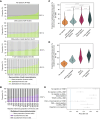The Clinical Relevance of the Infiltrating Immune Cell Composition in Kidney Transplant Rejection
- PMID: 38640017
- PMCID: PMC11230711
- DOI: 10.1681/ASN.0000000000000350
The Clinical Relevance of the Infiltrating Immune Cell Composition in Kidney Transplant Rejection
Abstract
Key Points:
The estimated composition of immune cells in kidney transplants correlates poorly with the primary rejection categories defined by Banff criteria.
Spatial cell distribution could be coupled with a detailed cellular composition to assess causal triggers for allorecognition.
Intragraft CD8temra cells showed strong and consistent association with graft failure, regardless of the Banff rejection phenotypes.
Background: The link between the histology of kidney transplant rejection, especially antibody-mediated rejection, T-cell–mediated rejection, and mixed rejection, and the types of infiltrating immune cells is currently not well charted. Cost and technical complexity of single-cell analysis hinder large-scale studies of the relationship between cell infiltrate profiles and histological heterogeneity.
Methods: In this cross-sectional study, we assessed the composition of nine intragraft immune cell types by using a validated kidney transplant–specific signature matrix for deconvolution of bulk transcriptomics in three different kidney transplant biopsy datasets (N=403, N=224, N=282). The association and discrimination of the immune cell types with the Banff histology and the association with graft failure were assessed individually and with multivariable models. Unsupervised clustering algorithms were applied on the overall immune cell composition and compared with the Banff phenotypes.
Results: Banff-defined rejection was related to high presence of CD8+ effector T cells, natural killer cells, monocytes/macrophages, and, to a lesser extent, B cells, whereas CD4+ memory T cells were lower in rejection compared with no rejection. Estimated intragraft effector memory–expressing CD45RA (TEMRA) CD8+ T cells were strongly and consistently associated with graft failure. The large heterogeneity in immune cell composition across rejection types prevented supervised and unsupervised methods to accurately recover the Banff phenotypes solely on the basis of immune cell estimates. The lack of correlation between immune cell composition and Banff-defined rejection types was validated using multiplex immunohistochemistry.
Conclusions: Although some specific cell types (FCGR3A+ myeloid cells, CD14+ monocytes/macrophages, and NK cells) partly discriminated between rejection phenotypes, the overall estimated immune cell composition of kidney transplants was ill-related to main Banff-defined rejection categories and added to the Banff lesion scoring and evaluation of rejection severity. The estimated intragraft CD8temra cells bore strong and consistent association with graft failure and were independent of Banff-grade rejection.
Trial registration: ClinicalTrials.gov NCT02832661.
Conflict of interest statement
Disclosure forms, as provided by each author, are available with the online version of the article at
Figures






References
-
- Naesens M Roufosse C Colvin RB, et al. The Banff 2022 kidney meeting report: Re-appraisal of microvascular inflammation and the role of biopsy-based transcript diagnostics. SSRN Electron J. 2023. doi: 10.2139/ssrn.4447700. https://papers.ssrn.com/abstract=4447700. - DOI - PubMed
-
- Roufosse C Naesens M Colvin RB, et al. The Banff 2022 kidney meeting work plan: data-driven refinement of the Banff classification for renal allografts. SSRN Electron J. 2023. doi: 10.2139/ssrn.4444233. https://papers.ssrn.com/abstract=4444233. - DOI - PMC - PubMed
Publication types
MeSH terms
Associated data
Grants and funding
- 305499/FP7 Health
- 1016 ROCKET, JTC2-29/Fonds Wetenschappelijk Onderzoek
- G087620N/Fonds Wetenschappelijk Onderzoek
- 1196119N/Fonds Wetenschappelijk Onderzoek
- 1143919N/Fonds Wetenschappelijk Onderzoek
- 1S93918N/Fonds Wetenschappelijk Onderzoek
- 1844019N, 1842919N/Fonds Wetenschappelijk Onderzoek
- DOS0060162/00/Bpifrance
- FC0013440/European Regional Development Fund of the Region Bourgogne Franche-Comté
- ANR-22-CE18-0011-01/Agence Nationale de la Recherche
- FC0013440/European Regional Development Fund of the Region Bourgogne Franche-Comté
LinkOut - more resources
Full Text Sources
Medical
Research Materials

